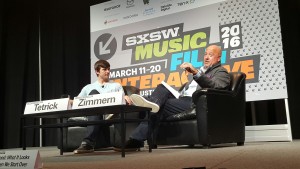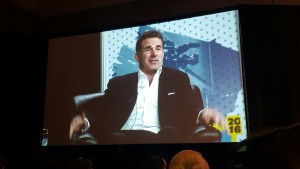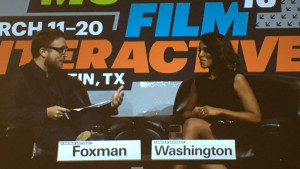We’ve been talking about technology and innovation so much the past week that we’ve half expected to come home and find more pamphlets and VR tech sitting on the kitchen table.
The Onion is quite right – innovation is what SXSW is about, and maybe we’ve heard enough of the same themes to get along with for a while. A video from Cracked.com joked, “You’ve all done a great job, but maybe we should just lay off on the innovation a while. Just cool it, OK?”
While it’s nice to poke fun at the digital world after a long day of ‘innovation,’ SXSW embodies what our world’s great minds are doing to advance the human race and beyond.
Here are just a few recurring themes we’d like to talk about:
Entrepreneurship coupled with social good
There’s been a push recently for buyers to choose their products more consciously by researching the brands they frequent. With more choices now than ever, consumers want more than just a great product; they want their dollar to go further than just the pocket of the company. They want to be able to make a difference in a way that benefits everyone.
One example of this was seen in the SXSTYLE panel “What’s More Important, Fashion or Impact?” Fashion stores like Austin’s Raven and Lily not only sell handcrafted jewelry, but jewelry that’s made by women in third world countries, who would not otherwise become employed.
The effect is not only jobs for an impoverished region, but also to empower women within their communities, who are often undervalued because they are not as suited as the men to contribute with hard labor. They also take pride in this work and know people are wearing their jewelry or clothing around the world.
Health consciousness and our food system
Consumers are becoming more conscious about the way their food is made as well as how their goods are made. But most importantly, they want food that is good for their bodies that are still suited for their on-the-go lifestyle.
The panel “Evolution of Fast Casual and the Shift to Mindful Eating” talked about the struggle of this balance. The New York fast casual restaurant By Chloe strives to do this (with vegan food), as well as the paleo-food-by-delivery company Freshly.
All panelists agreed that good, healthy food is hard to come by. Both founders created these with their own struggles in mind.

The panel “JUST Food: What it Looks Like When We Start Over,” featured Travel Channel foodie Andrew Zimmern and creator of Hampton Creek foods, Josh Tetrick. The discussion largely talked about the world’s failing food systems, in relation to other systems that are inseparable.
The unique advice from Tetrick was that socially and environmentally minded companies like his should not wait for legislation, but draft their own, and keep working to change the food system in a bigger way.
Another food session, “Eat This Panel (If You Dare),” looked at food myths surrounding the industry including knowing what terms such as “all natural,” “processed,” “gluten free,” “GMOs,” and “organic” really mean. The panel suggests that not only should the consumer be more wary of food labels, but food providers should be more conscious of what they’re telling their customers.
VR is big and the possibilities are endless
Virtual Reality is expected to be the breakout technology of 2016 and after just a few days at SXSW, innovative news media can and should jump at this opportunity.
“VR has presented itself as an exciting storytelling tool, being able to tell stories in a way that compels people to not just care, but do something,” Hayley Pappas, Head of Films for RYOT, said at her panel “Sucked Into The Story – VR and News.”
@sarashields011 testing out awesome technology at the #txstinnovation lab pic.twitter.com/cqsFb7aPmW
— SXTXState (@sxtxstate) March 13, 2016
The goggles are everywhere. Booths in the trade show, lounges, interactive panels, student project presentations, even at the job fair.
The panel “Creating Brand Fans: Lessons from Game Marketers,” briefly mentioned VR, which would inevitably become a part of the gaming world, but Dave Miller, the VP of Global Marketing for Warner Brothers Entertainment said, “You can start to see the implications outside of gaming.”
VR won’t be a game-changer for game consoles, but are going to play more groundbreaking roles in other fields, including journalism.
The New York Times is experimenting with the possibilities for investigative reporting on a virtual reality platform. At the session “New York Times Reality Through VR-Tinted Glasses,” Mark Thompson, President and CEO of The New York Times, pointed to the incredible opportunities for VR.
“My suspicion is that there are plenty of things we’re going to be able to do in journalism, and it’s very exciting,” Thompson said. “Virtual reality puts you in the middle of the story. It has potential in hard news, international news. Cameras will get lighter and there will be ever more possibilities.”
Entrepreneurship in tech
Entrepreneurship is obviously not a new topic, and the stories of brands and how their got their starts often contain the same elements: Creativity, practicality, drive to accomplish your goal and a disregard for worry/the competing brands.
But the conversation has another element at SXSW and that’s how they used tech in their creativity.
In the conversation with Under Armour CEO Kevin Plank, he brought up UA’s HealthBox. It’s essentially a combination of smart health-tracking tech. None of it is really new – it’s got a wristband, heartrate monitor, smart scale – except it’s app that allows the user to track the way they’re feeling every day, track days they’re sick, and better see the big picture of the trends. He also wants to expand this to bigger data and search applications for health data among users.

But what sticks with us is when he asks why we can look at every transaction we’ve made on our bank account, and look back years, but when we see a doctor, he looks at some scribbled notes from the last time we saw him 8-12 months ago.
So the innovation at this point isn’t necessarily new technology, but a new, practical application for existing tech.
Data
Perhaps we’re more in-tuned to data since a majority of our team is currently in an advanced coding class, but it’s something that was mentioned in many panels.
Again, with Under Armour, Kevin Plank wanted to use data generated from HealthBox users to create a better understanding of our health trends.
CEO of FashionABLE, Barrett Ward, says he wants his company to be accountable with the amount of good they are doing in third world countries. He says he’d like to have data that indicates if the economies have done better because of their presence, if people have more food because of their presence, if the peoples’ educations have been impacted by their presence. And data can show these trends in concrete terms.
NASA, of course, talked about data and the necessity of it to know how people can survive on the trip to Mars, and when they get there.
One novel use of data was discussed by Steve Moore of Physical Plant Theater. He spoke at a session dealing with an innovative new use of text messages: to deliver plays. People can attend plays throughout their day, regardless of their collection, via text-messages they receive from a variety of numbers representing different characters. In order to determine what users might be interested in different sorts of plays, Moore uses data. A subscriber who, for instance, likes horror films on Facebook might be more amenable to being offered to participate in a text play that involves receiving frightening messages at 2 a.m.
Diversity
While women in tech and other industries is still an issue that’s being addressed, minority men are getting pushed aside in the shuffle. Primarily, black and Hispanic males see the least opportunity when it comes to tech especially.
Christina Lewis Halpern, founder of All Star Code, told us that the tech industry will be looking to fill 1.4 million jobs by 2020 with only enough grads to fill approximately 70 percent of them. Meanwhile, men of color only fill about 3-4 percent of those jobs.
We also heard Kerry Washington speak on diversity in spheres outside of the tech industry. She discussed the ways in which she has leveraged her fame to promote better practices for the representation and increased inclusion of black woman by mainstream brands.
The intersection of social media and fame
The social sphere is saturated with fame. People who are famous for more traditional reasons are compelled to maintain an active presence on social media and others acquire their fame by using the platforms at their disposal to get people talking.
At this year’s SXSW there was plenty of discussion that approached the intersection of fame and social media from both angles.
On one end of the spectrum was Kerry Washington, who spoke about her approach to using social media during her featured session. On the other was a session featuring a panel of social media stars, King Keraun, Dante Basco and Christian DelGrosso, discussing their paths to stardom. Across both of these sessions a theme emerged: organic content.
Washington was clear that her account is not a highly worked-over space. While she opts out of sharing much of her private life, she does use social media to enact change. Her activist leanings were, as discussed above, out in full force as she discussed the ways that she has used her celebrity status to engage in conversations that resulted in better representation of black women on magazine covers and more inclusion for women of color in mainstream makeup brands like Neutrogena.
The social media stars, of sharply contrasting backgrounds, gave advice to aspiring social stars. Their message was a mantra many of us have heard: content is king. Chasing followers rarely yields results because the content it inspires often feels forced. The panelists urged potential stars to focus their energy on making good content that felt organic.

